HOW TO CREATE AN IDEAL MBA RESUME
10 Steps Towards Creating
the Perfect MBA Resume
It’s not uncommon to hear MBA applicants spending hours revising for their GMAT, and subsequently perfecting every word of the essays, and though this attention is well warranted, these applicants woefully ignore an integral part of the application process, the Resume.
The resume may just be the most important part of the application, because not only is it the first thing the admission committee reviews when they receive your application (think first impression)
But it is also the document which they will constantly refer to, while clarifying any doubts, with respect to your application essays and overall profile
and if that’s not enough, it’s the resume which would largely dictate the kind of questions addressed to you during your final interviews.
Hence there is no question regarding the importance of this 1-page piece of document.
That said creating an effective and powerful resume is no easy job.
Though there are a number of articles on resume writing, a majority of them lack depth, and even fewer give a step by step process to create an MBA Resume, from scratch or otherwise.
Via this resource, we aim to create the definite go-to guide for creating an effective MBA resume, and hence have covered everything- from the format and font type, to bullet structure and what data to include in the work experience part as well as in the extracurriculars.
To start off, we will be analyzing the anatomy of the ‘Perfect-Resume’, giving you tips along the way to make sure your resume shines.
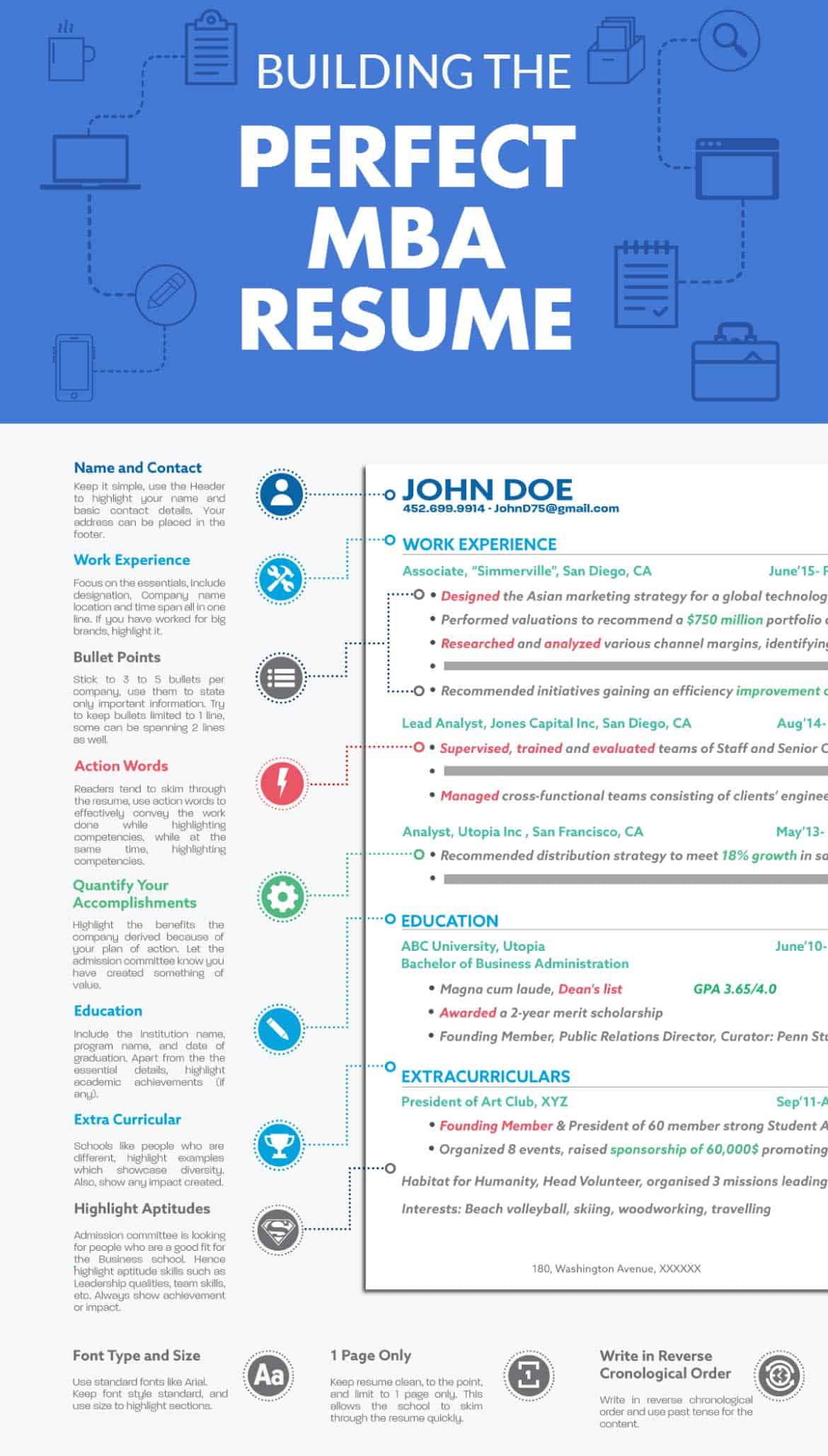
Now that you have a general understanding of what an MBA Resume should and should not contain, let’s go through each section step by step.

GET A CLEAN AND EFFECTIVE RESUME FORMAT
One golden rule to follow while creating an MBA resume is to limit it to 1 page. Even schools such as Wharton and ESADE stand behind the one page format rule.
Neither do you have the experience to pull off a 2-page resume, nor does the admission committee have the patience to go through the needless data that may be populating the resume.
You want the resume to be clean, to the point and easily scanable, in short, you want to make the job of the reader easy.
We believe the MBA resume should adhere to specific format rules which we have given below-
Format your resume in MS Word for Tables, Margin, and Alignment.
Have standardized margins 1 inch on top and bottom and 0.63 inches on the sides.
Check for the indents in each section.
Use gridlines and rulers to align.
Sounds too complicated?
You have got online tools such as myperfectresume.com, resumebuilder.org, resume-now.com to make your life easier.
Or
You can just download a free MBA resume sample from websites such as ResumeGenius and edit data in MS Word as per your needs.

STANDARDIZE THE FONT TYPE AND SIZE
What should the font size be?
The header should be sized between 20 and 22, section head could range from 12 to 14, while the main body should be between 10 and 12. Use a standard font like Arial.

You could also choose from Calibri, Garamond, Trebuchet MS, Georgia, and Helvetica. These fonts are legible, will give a fluid look and make your resume stand apart from other resumes.
A word of caution here, don’t try to mix and match fonts.
Stick to one throughout the resume.
Also, use bold, italics, etc to organize your resume.
If you keep the text in your resume plain, it will look dry and not easy on the eyes.
For example, you can bold the name of the companies you have worked in, the name of your college/ university, your designation in the company or while highlighting a specific action word or important stat.



PROVIDE RELEVANT CONTACT DETAILS
Start your MBA resume with your name and basic contact details.
Just like the title of a book gives that particular book a unique identity, your name will give a unique identity to your resume. Therefore, your full name should be at the very top of your resume.
Mention your phone number along with country code and an appropriate email address. Refrain from using inappropriate email like [email protected] It is best to stick to some variation of your name that seems official.
For example, if your name is John Doe, a good email username can be [email protected]
In the header, the phone number and email address should be enough in most cases.

You can also include a link to your LinkedIn profile, but make sure it is updated and matches with the resume.
The rest of the details such as full address can be mentioned in the Footer.

SKIP THE OBJECTIVE STATEMENT
In the 80’s it was a common practice to include objectives in your resume. Times have changed now, neither hiring managers nor the ad com is interested to read your objective as it seems vague and mostly generic.
The admission committee is interested in your skills and capabilities and the objective is not able to state that.

Remember, every word in the resume counts, listing an objective for MBA admissions will eat up a lot of space.
For example:
Let’s say, that an ad com member sees this objective written on the MBA resume of a candidate

If you analyze this statement it tells nothing suitable about the skill set or the experience of the candidate.
It sounds ambiguous at the best.
Also, who does not want to work in such an environment? So there is no differentiation factor here.
Hence the lesson here is, skip the objective statement.

OPTIMIZE YOUR BULLET POINTS
Bullet points are the most effective way to express information, use them well.
Stick to 3-5 bullet per company. The more recent or diverse the job experience the more bullet points can support it.
Also, remember that readers like to skim through data hence large blocks of text will not be read.
Keep your bullets to 1 – 2 lines (and, ideally, about half or more of those bullets should be one line).
They should be the same size and shape in each section and aligned from page to page.


Coming to the content of the bullets, here are some things you need to take care of
i) Quantifying Data Points
An important thing to remember is to quantify the work you have done so that the admission committee knows you have gone ahead and created something of value.
This way you make sure that the ad com understands the work you did as well as the impact you create.

Here are some examples of Quantification

As you can see the impact is clearly visible
Another way the impact of a bullet point can be exponentially increased is by using an Action word.
ii) Action Words
So what are Action Words?
Action Words play an important role at the start of every bullet point. Think of skimming through a resume and coming across word such as “Was, Did, and Made”, as opposed to “Managed, Spearheaded and Created”.
The latter group of words sounds more interesting, stronger and can help you set the tone for your resume.
Similarly, while using an action word sometimes the same job can be described in different a manner, creating a completely different impression for the reviewer.
For example, consider these two statements:
- Filing system was upgraded by my team…
- Initiated and managed complete overhaul of company information management system… The second statement highlights the exact work done while making the point informative and adding weight to it.


Other examples of how you can use Action word: –

Hence make sure you start most of your points with action words.
In fact, most companies have softwares which search specifically for such action words and filter resumes based on it.
Hence you can realize the importance of the same.
Action word comes in varied forms, here are some mentioned below: –
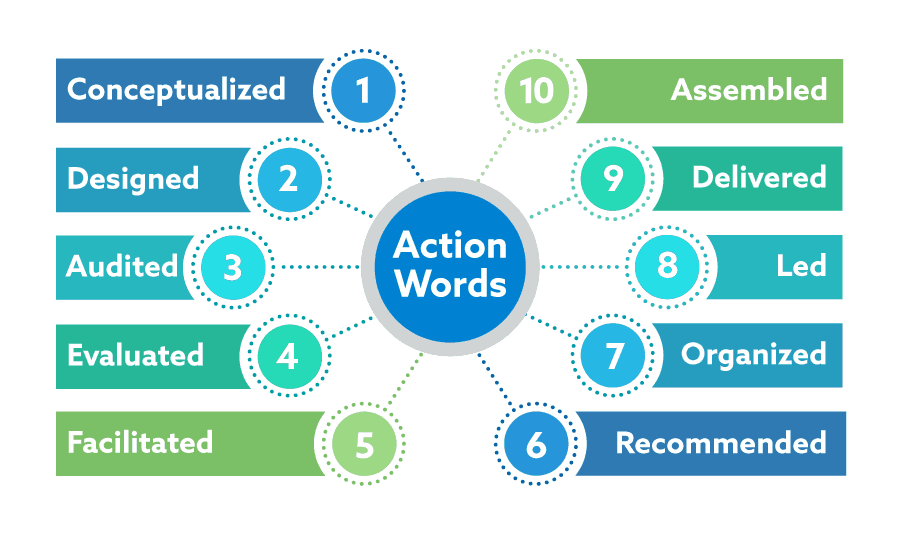
Now that you have the basics of creating an MBA resume, time to look into the content

EFFECTIVELY HIGHLIGHT YOUR WORK EXPERIENCE
This is the most important section of your MBA resume so make sure you perfect it.
For starters,
Include your designation, the company name, location and the time span you worked.
Try to put all of this in one single line, so you do not lose much space

While brainstorming the content for the bullet points under each role, remember to not just talk about your responsibilities, but also write the benefit the company derived because of your plan of action.
i) ” So What? ” Test
You can use the “So What?” test for it

After writing a bullet point, analyze the content ask yourself ‘So what?’ to check whether the point highlights your capability.

Think about what difference it made?
How much faster? What was it before? How much money or time did it save?
So it can be converted into something like

Now here you have highlighted that you are aware of project management skills, you strived to complete a project before time and your efforts resulted in a market share of 70%.
ii) Transforming bullets from “Meh” to winning examples
We all have seemingly ordinary jobs and have taken up and completed a slew of nominal responsibilities
But these seemingly regular tasks at your work need to be made more appropriate for an MBA application resume.
A good starting point could be adding precise facts or tasks accomplished to make those points come alive.
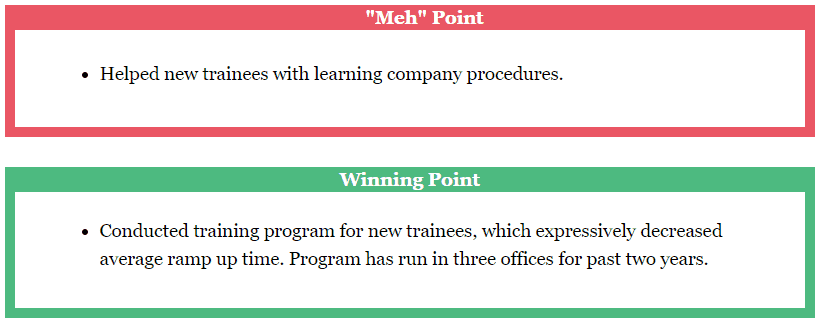
Now that you have the basics of creating an MBA resume, time to look into the content
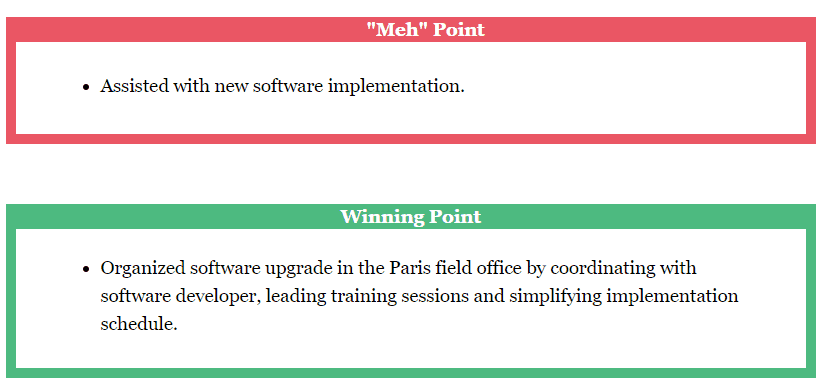
As you can see adding facts and developing the point accordingly can make a huge difference
iii) Translating Technical Jargon into MBA Language
Applicants for MBA schools are from all walks of life, from engineers to doctors, hence it is essential to avoid technical jargon which a person from a different background will have trouble understanding.
Hence take special care while talking about activities pertaining to work on specific computer programs, programming languages, company acronyms and other lingo which may cause a reader to become confused.
Check out these examples and observe how to make content more understandable to the MBA Admission committee.
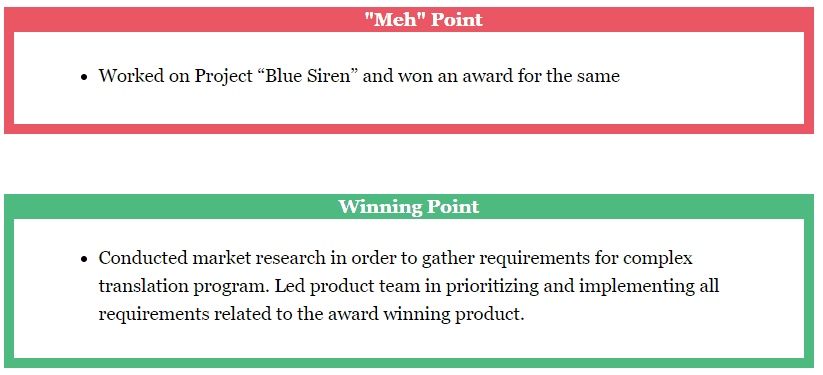
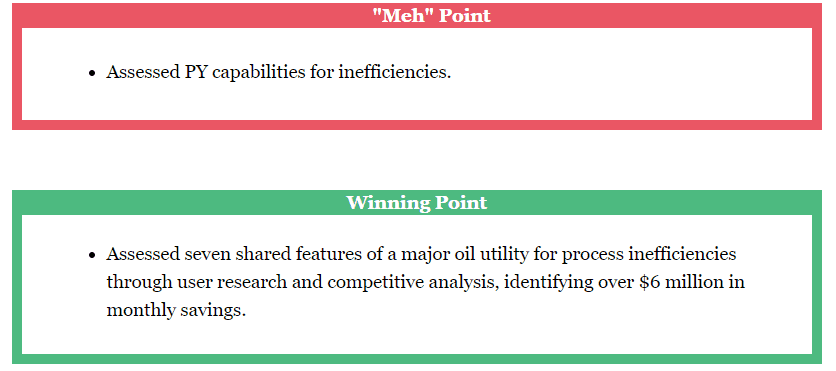
To say the least make sure you put yourself in the reader shoes, and craft points in a manner which will be easy for him to understand.
Another thing to remember is to write this section in reverse chronological order. So your current job role comes first followed by previous internships.

Lastly, make sure all job responsibilities apart from your current job are in past tense.
Nothing puts forward a bad impression like bad grammar.
Note: If you are a fresher, your MBA resume may look bare. Introspect on internships done, or any freelance jobs which you might have done and the skills gained.
If you have done your final year projects with some external research/industrial entity – that can be mentioned here under Internship.

SHOWCASE YOUR EDUCATIONAL BACKGROUND
A very important part of your background
This section must include the institution name, the program name, and the date of graduation.
Also, it is not a good idea to mention anything further your Bachelors, especially if you have some work experience.
If you have done your masters or some other course as well, you can surely mention those as well.

Try adding some points that will serve as highlights, such as academic honors, club positions or any other achievement you have which might be relevant to your workspace.
If you had got a scholarship then be sure to mention it right away.
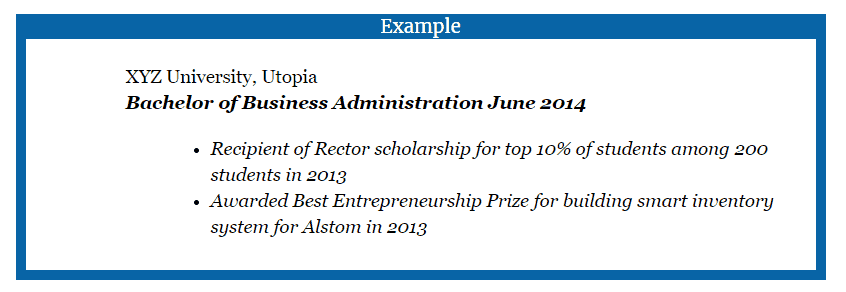

DIVERSIFY WITH EXTRACURRICULARS
Schools are looking for more than just office drones or ivy league undergraduates.
They want people who have a holistic profile, who will add diversity to the school and their cohort, and who have some varied experiences in life.
The Extracurricular Activities section can provide you with that Competitive Edge.
Spanning from organizational activities highlighting one’s leadership potential to social activities which highlight one’s empathetic nature or will to create an impact.
Extra curriculars can be varied in nature, hence it may be a good idea to use this space wisely, and highlight some aspects of your profile which differentiate you from the crowd and which the schools would appreciate.
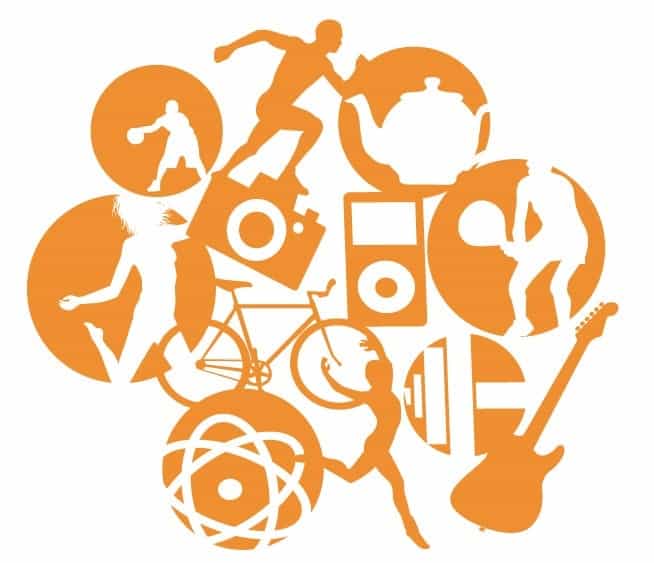
Given below is a list of some extra-curricular activities that can be a good fit in this section
- Being a member of an academic club such as Poetry club, Engineering club, Psychology club etc.
- Heading or being part of a team participating in a competition such as Robotics competition, Chemistry Olympiad, Clean Tech Competition etc.
- Engaging in activities related to art such as photography, dramatics, ceramics etc.
- Being part of a cultural club such as Russian Club, Pacific Islanders club, South Asian Student Society etc.
- Participating in community activities such as JUNTOS, Mountaineers club etc.
- Participating in a government related activity such as being member/leader/active participant of a student government, student council, community government etc.
- Engaging in leadership related activities such as National Beta club or Peer leadership group.
- Involvement in writing, media-related activities such as working on a movie, writing for school/local newspaper etc.
Volunteering experience for a cause or for an NGO.
Another fact to consider here is that just mentioning the activities is not enough, anybody can participate in a NGO or do Yoga.
What matters is what impact you created in the same, so focus on that.
Also, you can emphasize on leadership activities and how you have guided people towards a common goal.

If confused about what Extracurricular to focus on, you can think along the following lines:
- Leadership: Highlighting the work done while managing a group of people. Also add challenges faced, your vision for the entire team and results achieved.
- Volunteering Initiative: The initiatives can show the balance you strike out by managing your studies/office and voluntary service together.
- Training Others: Training, Mentoring, Teaching, like training your peers, mentoring new hires are all interconnected to leadership and worth mentioning in the resume.
- Recruiting efforts: If you have taken effort in recruiting for your club, a company, etc then this shows that leaders of your company, respect you and trust you with the responsibility to get the best job done.
and so on…
If you still have space left, you may want to add some additional info
List your non-trivial hobbies/interests/activities/leadership positions. Try to mention only slightly uncommon and interesting things.

Skills like proficiency in a language like French, Spanish or German etc can be highlighted here.

Lastly, it is time for the checklist
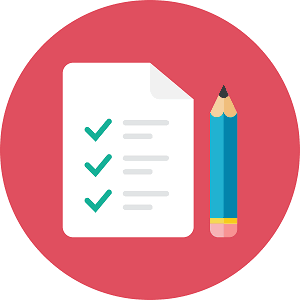

PERFECT THE GRAMMAR!

Your resume is your introduction to the admission committee. It’s their first impression of you, and the last thing you want is to look careless or silly. Resume grammar mistakes can completely sabotage your chances of getting into your dream school.
Some kinds of resume grammar mistakes are word choices, spelling errors, and punctuation errors.
In order to avoid such mistakes, make sure you have the resume proofread from another person
Also, there are some other things you can look into to give your resume that extra edge
i) Active Voice vs Passive Voice
Active voice describes a sentence where the subject performs the action stated by the verb.
In passive voice sentences, the subject is acted upon by the verb.
To craft a powerful resume, avoid passive language as much as possible. Write the resume using active voice.
Not only is it better grammar to use the active tense, but it also conveys a more direct, driven and in control feeling from the resume.
Passive Voice (seems as if the promotion just happened)

Active Voice (gives the candidate more credit for the activity)

ii) Make correct use of Tense
- When talking about earlier Jobs and responsibilities held; always refer to them in the past tense
- When talking about your present job and responsibilities; use the present tense
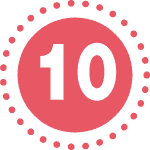
PROOF READ! PROOF READ! PROOF READ!
You don’t have to be a grammar nazi! But you cannot make silly grammar errors.
Use read out loud function in MS Word to hear your resume and check for mistakes.
DO NOT rely on MS Word for spell check as it doesn’t have contextual spell check.
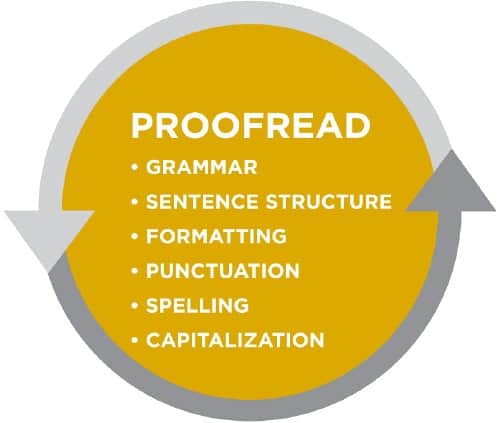
You can also use online tools such as Grammarly or Reverso.
If you have included a link to your LinkedIn or any other web page, check if they lead to the correct page when clicked.
Recheck to ensure that Fonts and sizes in your resume must be consistent among all sections.
Use a line break between sections to make the resume as skimmable as possible.
Lastly, make sure you get your resume proof read by a few friends/colleagues, you will be surprised how many mistakes one can miss even after several reruns through the resume.
CONCLUSION
Several people underestimate the effort that goes into crafting an effective resume.
As you may have just seen, a good MBA resume is not just a simple sheet of paper with your profile data scrawled across it,
but it has to be engineered to perfection, taking into account several factors.
Make sure you take the pointers given above into account and we can assure you that your resume would be better than 80% of your competitors.
Below you can see the top 60 B-Schools that offer MBA to early career graduates
Best of luck for the application from everyone at MiM-Essay.com!
Now that the resume is done are you looking forward to take your college essays to the next level?
Check out our Masters Essay Editing Services.